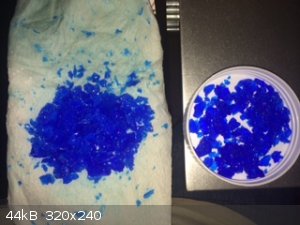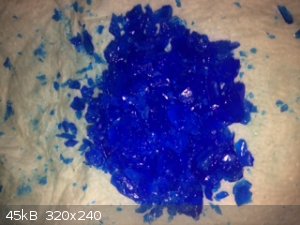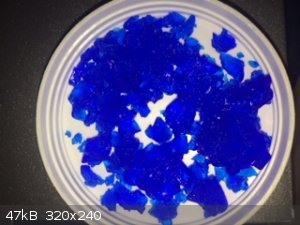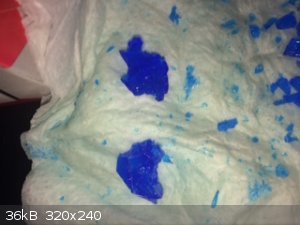Sniffity
Hazard to Self
 
Posts: 70
Registered: 27-12-2014
Member Is Offline
Mood: No Mood
|
|
Crystallization - Cooling vs. Evaporation
Hey,
I've been growing copper sulfate crystals via the cooling method. However, I'm aware of the existence of the evaporation method...
Usually, I save my mother liquor and then recover the remaining copper sulfate in it via evaporation. I then proceed to re use this copper sfate in
subsequent cooling crystallizations.
However, I've found some information saying that crystals grown via the evaporation method are just as pure as those grown from cooling. Upon
comparing my two crystals, one grown via cooling and one grown via evaporation, I find the cooled crystal to be much purer, much darker in colour,
etc...
Sooo... Do these two methods yield equal quality crystals? Should I leave the choice of method to my own personal preference? Or am I right in
assuming the cooling method gives purer crystals?
[Edited on 6-1-2015 by Sniffity]
|
|
|
Pasrules
Hazard to Self
 
Posts: 78
Registered: 4-1-2015
Location: Yellow Cake Deposit
Member Is Offline
Mood: Lacking an S orbital
|
|
I would expect during the cooling that the purest of your copper sulfate will precipitate out as the solubility point decreases.
Where as in the evaporation method the remaining copper sulfate will deposit which could have possible impurities as the impurities may generally
speaking increase the solubility however i have seen this effect in reverse.
I will try to find a publication on this for precipitation in general.
Could you try taking your purest copper sulfate from the cooling method and make up two separate hot aqueous solutions then cool one and evaporate the
other and compare as this way you will have a starting sample of the same purity. It would be great to see some photos.
My intuition (citation needed) would think that cooling occurs in a 3-dimensional way where evaporation is 2-dimensional. This could effect the
crystallization process but is only a gut feeling.
[Edited on 7-1-2015 by Pasrules]
Atropine, Bicarb, Calcium.
|
|
|
subsecret
Hazard to Others
  
Posts: 424
Registered: 8-6-2013
Location: NW SC, USA
Member Is Offline
Mood: Human Sadness - Julian Casablancas & the Voidz
|
|
Probably not. As you evaporate the water from the solution, the impurities become more concentrated, and have a greater chance of being incorporated
into the CuSO4 crystal. I recommend the cooling method.
[Edited on 7-1-2015 by Awesomeness]
Fear is what you get when caution wasn't enough.
|
|
|
Artemus Gordon
Hazard to Others
  
Posts: 178
Registered: 1-8-2013
Member Is Offline
Mood: No Mood
|
|
I have heard that fast crystallization can trap impurities in the crystals, but my guess is that as long as you pull your crystals out while you still
have a lot of water you will keep the impurities in solution. Also, rinsing your crystals with either very cold distilled water or acetone will
improve purity. I had a small beaker full of rather impure CuSO4 solution that I put a watchglass on as a cover and let slowly evaporate to
full dryness, after running it through filter paper to catch any undissolved impurities. I got some lovely large CuSO4 crystals with
well-defined and large faces, so I think they are pretty pure. I also got some interesting translucent brown needle crystals that were well separated
from from my copper sulfate crystals, so it would seem that the two substances maintained good segregation even as the water shrank away to nothing.
|
|
|
subsecret
Hazard to Others
  
Posts: 424
Registered: 8-6-2013
Location: NW SC, USA
Member Is Offline
Mood: Human Sadness - Julian Casablancas & the Voidz
|
|
A good way to slow crystallization is to get a thermos (or some sort of Dewar-type container), preheat it with boiling water, and then place the
sample inside. The double wall ensures that the solution cools slowly.
Thanks for the acetone tip, Artemus. It's got the advantage of dissolving impurities that aren't soluble in water, as well as drying
the crystals (though I don't think you'll find many organic impurities in technical CuSO4.
Fear is what you get when caution wasn't enough.
|
|
|
Praxichys
International Hazard
    
Posts: 1063
Registered: 31-7-2013
Location: Detroit, Michigan, USA
Member Is Offline
Mood: Coprecipitated
|
|
Don't bother with evaporation unless your compound is sensitive to heat. It is very slow and usually results in dust contamination.
Boil to saturation point, cool to near freezing, filter, wash crystals with ice cold solvent.
Boil the filtrate again to saturation point, cool to near freezing, filter, wash crystals.
Repeat as necessary. If you know your impurities, you can look up their solubility curves and make sure you stop before they also begin to
crystallize. Be aware of the common ion effect. You can also cool a sample of the saturated solution onto a watch glass and use a microscope or
magnifier to make sure there is only one type of crystal coming out of solution.
Vacuum filtration will speed up the process. Leaving it on the vacuum will help remove water, or as Artemis said, washing with some fast-evaporating
liquid that the crystals do not dissolve in like acetone. Just be sure that you aren't introducing further impurities. Many commercial acetone brands
contain rust inhibitors. You can see them by evaporating some acetone on a glass surface - it should not leave a spot.
If the first crystallization exhibits unacceptable purity, re-dissolve them and do the process again. Each time around will refine the product more.
I find that hardware store CuSO4 is easy to purify this way. First dissolve it in a minimum of warm water, pull it through a filter to remove dirt and
the anti-caking agent, and then use the above process to recrystallize.
|
|
|
deltaH
Dangerous source of unreferenced speculation
    
Posts: 1663
Registered: 30-9-2013
Location: South Africa
Member Is Offline
Mood: Heavily protonated
|
|
I have grown MASSIVE CuSO4 crystals by very slow evaporation (nearly a year). I placed nearly room temperature satured
solution of CuSO4 in a 2l plastic soft drink bottle (full) and simply left it with the small lid open (diameter about 2cm). This actually happened by
accident  A year later I rediscovered the bottle, it had intergrown crystals on
the base about 5 by 8cm on the base, part had grown in the shape of the bottle, but the upper parts were perfectly facetted. One of my ex's
commandeered it A year later I rediscovered the bottle, it had intergrown crystals on
the base about 5 by 8cm on the base, part had grown in the shape of the bottle, but the upper parts were perfectly facetted. One of my ex's
commandeered it 
I suppose you could use the same trick with gallon bottles to make for larger surfaces on the base for the crystals to grow on, the secret is to slow
evaporation by having a smaller diameter opening at the top.
|
|
|
Sniffity
Hazard to Self
 
Posts: 70
Registered: 27-12-2014
Member Is Offline
Mood: No Mood
|
|
Wow! Thanks for all the amazing replies!
@ Pasrules
I was looking for an article too, but failed to find it. I'll post a picture of the crystals I have in a few minutes. Problem here, though: The
crystals grown via evaporation were made using the mother liquor from the crystals grown via cooling. Purity of the initial solution was clearly not a
controlled variable.
Might try to start two brand new crystallizations with each of the different methods and post results as well.
@ Awesomeness
Yeah, this was kind of my thinking, that by evaporation you could in fact precipitate inpurities that were soluble at room temperature out, which
would not be convenient.
@ Artemus Gordon
I've usually done the wash with cold distilled water. When washing with acetone, how do you go about evaporating it?
I believe I've read that acetone is used to protect copper sulfate crystals if you're going to be handling them (Say, at a science fair) which would
suggest they tend to stick to the walls of the crystals, reducing their slightly irritant properties.
Might be mistaken though, just kinda remember reading about that.
@ Praxichys
When you say boil the filtrate to saturation... do you mean boil the filtrate and let cool again? Or add more CuSO4 to the filtrate, boil and let cool
again?
What I tend to do with the filtrate is evaporate it, and treat the resulting crystals as impure CuSO4. Meaning: I'll grind them up, and throw them in
the next cooling crystallization.
@ deltaH
I believe I saw your post about the 1.3 kg crystals somewhere else here! Was that you?
I'm thinking of using an emptied out egg-shell, as amazing as that may sound. Hoping to get a crystals in the shape of the egg, and then crack the egg
shell open! Might just work!
|
|
|
Artemus Gordon
Hazard to Others
  
Posts: 178
Registered: 1-8-2013
Member Is Offline
Mood: No Mood
|
|
Quote: Originally posted by Sniffity  | Wow! Thanks for all the amazing replies!
@ Artemus Gordon
I've usually done the wash with cold distilled water. When washing with acetone, how do you go about evaporating it?
I believe I've read that acetone is used to protect copper sulfate crystals if you're going to be handling them (Say, at a science fair) which would
suggest they tend to stick to the walls of the crystals, reducing their slightly irritant properties.
Might be mistaken though, just kinda remember reading about that.
|
Acetone evaporates really easily, so it wouldn't "stick" to the crystals for more than a few minutes. The thing about CuSO4 is that if you
leave your crystals in open air for a long time they give off water and turn to the anhydrous form - a blue-white powder, so I'm guessing the
idea you read about is to submerge the crystals in a sealed clear bottle of acetone to preserve them. (CuSO4 is highly insoluble in
acetone.)
To rinse your crystals put them in something that will let the liquid acetone run off, such as a small sieve, and then use a squirt bottle or
eyedropper to rinse the crystal surfaces with a stream of acetone. As it runs off, it will carry away impurities and the small amount that adheres to
the crystals then evaporates in a few minutes.
[Edited on 7-1-2015 by Artemus Gordon]
|
|
|
deltaH
Dangerous source of unreferenced speculation
    
Posts: 1663
Registered: 30-9-2013
Location: South Africa
Member Is Offline
Mood: Heavily protonated
|
|
No that wasn't me... sounds like a whopper though!
|
|
|
subsecret
Hazard to Others
  
Posts: 424
Registered: 8-6-2013
Location: NW SC, USA
Member Is Offline
Mood: Human Sadness - Julian Casablancas & the Voidz
|
|
Quote: Originally posted by Artemus Gordon  |
Acetone evaporates really easily, so it wouldn't "stick" to the crystals for more than a few minutes. The thing about CuSO4 is that if you
leave your crystals in open air for a long time they give off water and turn to the anhydrous form - a blue-white powder, so I'm guessing the
idea you read about is to submerge the crystals in a sealed clear bottle of acetone to preserve them.
[Edited on 7-1-2015 by Artemus Gordon] |
Are you sure? Wikipedia states that the pentahydrate decomposes at 110 C. They won't dehydrate upon standing in air. You can also use sulfuric acid to
dehydrate them, as shown here:
https://www.youtube.com/watch?v=J1zwFwmANw4
Fear is what you get when caution wasn't enough.
|
|
|
DraconicAcid
International Hazard
    
Posts: 4278
Registered: 1-2-2013
Location: The tiniest college campus ever....
Member Is Offline
Mood: Semi-victorious.
|
|
Quote: Originally posted by Awesomeness  |
Are you sure? Wikipedia states that the pentahydrate decomposes at 110 C. They won't dehydrate upon standing in air. You can also use sulfuric acid to
dehydrate them, as shown here: |
In dry weather, your beautiful dark blue crystals will go pale and crumbly around the edges.
The Merck Index actually says that it will two waters to form a trihydrate at 30 oC, another two at 110 oC, and the final one at 250 oC.
I keep meaning to let a solution of it evaporat4e slowly in an oven at 40 oC and see if I can get crystals of the trihydrate.
Please remember: "Filtrate" is not a verb.
Write up your lab reports the way your instructor wants them, not the way your ex-instructor wants them.
|
|
|
Artemus Gordon
Hazard to Others
  
Posts: 178
Registered: 1-8-2013
Member Is Offline
Mood: No Mood
|
|
Yeah, I blew it when I said "anhydrous", but I have a crystalizing dish full of a mass of small blue pentahydrate crystals that are slowly turning
white and powdery just sitting on a shelf. No added heat or nuthin'.
Interestingly, it behaves as if it were a culture growing in a petri dish. It started as a single small white area which has grown into the blue like
a single "infection". I would have expected a random distribution among the crystals, but apparently a dehydrated crystal accelerates the drying of
its neighbors.
[Edited on 7-1-2015 by Artemus Gordon]
|
|
|
Sniffity
Hazard to Self
 
Posts: 70
Registered: 27-12-2014
Member Is Offline
Mood: No Mood
|
|
Okay, I've got the pictures.
Here we go:
The one on the paper towel is grown via evaporation, the one on the container lid is grown via cooling.

|
|
|
Sniffity
Hazard to Self
 
Posts: 70
Registered: 27-12-2014
Member Is Offline
Mood: No Mood
|
|
Second picture, close-up of evaporation crystals.

|
|
|
Sniffity
Hazard to Self
 
Posts: 70
Registered: 27-12-2014
Member Is Offline
Mood: No Mood
|
|
Third picture, close-up of cooling crystals.

|
|
|
Sniffity
Hazard to Self
 
Posts: 70
Registered: 27-12-2014
Member Is Offline
Mood: No Mood
|
|
Fourth picture.
Crystal on top is cooling method, crystal on the bottom is evaporation method.

|
|
|
Sniffity
Hazard to Self
 
Posts: 70
Registered: 27-12-2014
Member Is Offline
Mood: No Mood
|
|
Bumping this to see if anyone has any opinions on the pictures posted.
|
|
|